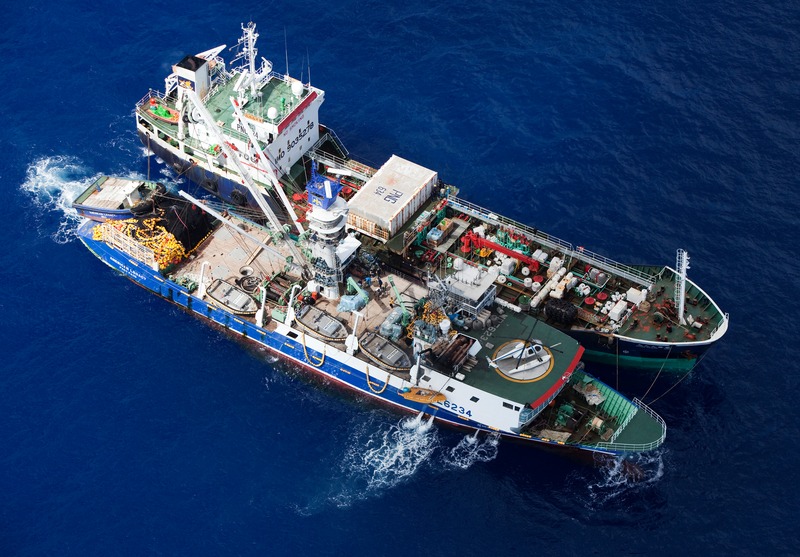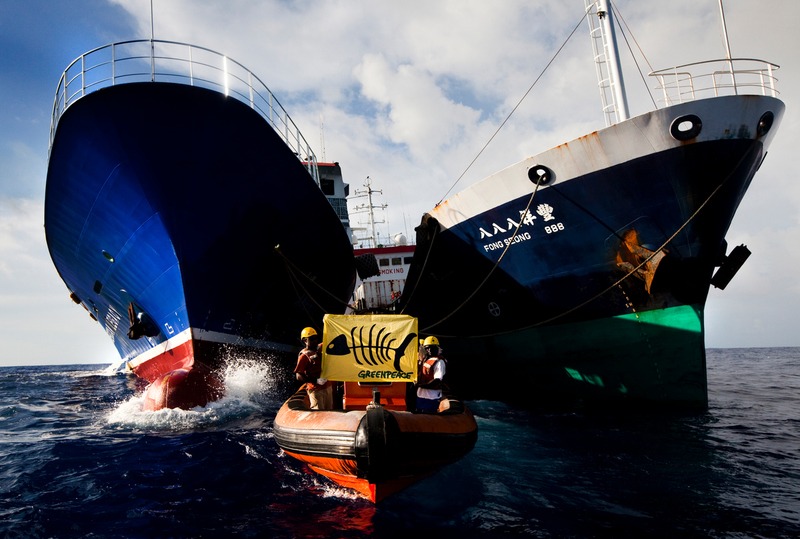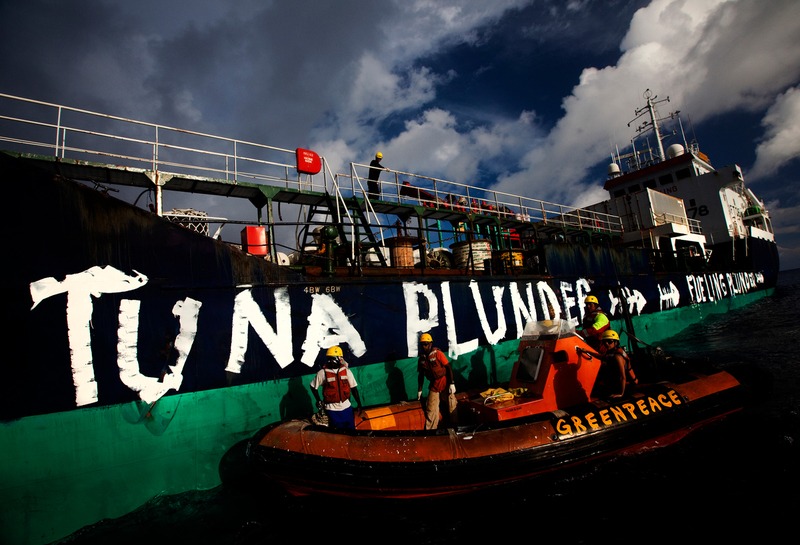
US-flagged American Legacy fishing vessel(L) and the Panamian- flagged MV Fong Seong 888(R) are pictured transhipping fuel in the Pacific Ocean, 17th September 2009.
The fuel tanker Fong Seong 888 refueling the purse seiner MV American Legacy. Both are owned by the Taiwanese Chen family network of Companies.
The number 8 in the Chinese culture is considered a lucky number, as the word for eight sounds similar to the word meaning ‘prosper’ or ‘wealth’ . I am pretty sure the Chen family network of companies had this in mind when they included the triple 8 to imbue good luck to their fuel tanker, the MV Fong Seong 888. Good fortune and prosperity.
However, its high seas activities instead mean bad fortune and poverty for the Pacific nations.
The MV Fong Seong 888 was refueling the purse seiner, American Legacy in the high seas, near the waters of Kiribati when we found them.

Greenpeace activists display a banner depicting a skeleton of a tuna between the hulls of USA-flagged American Legacy fishing vessel and Panama-flagged vessel MV Fong Seong 888.
The ownership of both vessels links back to the Chen family, a Taiwanese network of companies. But although these two ships share an owner, they both fly under two different flags: the Fong Seong 888 is flagged to Panama while the American Legacy is a US-flagged purse seiner.
Strange to hear, you might say, that these Taiwanese owned ships are using another country’s flag? This practice of using or flying the flag of another country other than the country of ownership, is what is known as ‘flags of convenience’ (FOC) . This is done for many different reasons, including cheap registration fees, low or almost no taxes and the freedom to employ cheap labor. But to the fishing industry, flying flags of convenience also makes it possible to artificially increase the fishing quota from what is assigned to individual nations. And what does this mean? They can fish more than they would be allowed to if they flew the flag of their real country.
Under an agreement called the US Treaty (http://www.ffa.int/taxonomy/term/441), the United States is entitled to fish in the waters of 16 Pacific nations with up to 40 purse seine vessels. In recent years, the country has had fewer boats than that, but new vessels are being added, flying the US flag though linked to a major shipbuilding and fishing conglomerate in Taiwan. Fresh from the biggest shipyard in Taiwan, flying the flag of the country with the greatest access to Pacific tuna resources comes the American Legacy. What hope do the tuna have with an alliance like that pitched against them?
Did I forget to mention the LAST refuge of the LAST relatively healthy stocks of tuna is found here in the Pacific? Scientists have been warning for years that the fishing pressure on Pacific tuna must be reduced, yet the American Legacy left the shipyard in Taiwan only last year. Amidst warnings of overfishing and calls for restraint, this brand new super-seiner joined the already vast number of fishing vessels out at sea chasing fewer and fewer fish.
Now let’s turn to the Fong Seong 888, one of many tankers operating in the Pacific. These tankers, along with the refrigerated “reefer” vessels that transfer fish, enable fishing fleets to stay at sea for extended periods. Without having to come into port to refuel, take on supplies and land the fish they have caught, it is much more difficult for authorities to monitor tuna catches in the region. These supply vessels open a gateway for illegally caught fish to leave the region untraced – they are literally fueling and fostering the continued plundering of tuna from the Pacific.

Greenpeace activists paint “Tuna Plunder – Fueling Plunder” on the hull of the Panama- flagged MV Fong Seong 888 after it refueled the US-flagged American Legacy fishing vessel.
To show our protest for this shameful practice, our Greenpeace activists painted, ‘Fueling Plunder’ and ‘Tuna Plunder’ on the hull of the MV Fong Seong 888. It was one of the fastest ship painting actions I have ever seen! And with good cause: having already finished their refueling, we barely had time to paint the campaign message when the purse seiner, MV American Legacy broke away from the starboard side of Fong Seong 888, and headed away at speed.
Maybe they were afraid we would ‘dirty’ their hull too! That fresh new paint on an industrial fishing vessel, added to the bloated fishing capacity in the region even though scientists were warning of overfishing and countries were agreeing to show restraint.
As I look back at the 3 weeks we have been here in the international waters of the Western Pacific, we have come across FADs, documented an illegal transshipment at sea, confiscated longlines and escorted several vessels out of the high seas. This latest deplorable activity – a brand new fishing vessel being refueled at sea – was perfectly legal, yet illustrates the problem of countries building yet more ships when there are already too many, the question of flag state responsibility, and the curse of refueling and transshipment at sea. It is amazing just how many loopholes these companies find through which to carry out their operations. If only the fishing nets were this full of loopholes – I doubt that a single tuna would be caught!
With all the resources at their disposal and the capacity to circumvent, exploit and abuse bans and treaties, what will it take to stop these distant fishing nations from robbing the Pacific nations of their own resource?
While our activists painted the hull of the Fong Seong 888, I was watching all the activity from the bridge. As the purse seiner American Legacy broke away set a course, the horizon where she was headed was dark with rain clouds, while amazingly at the stern of the Esperanza, the sun was shining at its brightest! In my mind’s eye I could see the two roads that the Pacific fisheries are facing at the moment: one heading towards a dark future of the continued plunder of the Pacific until this ocean is fished to death, while the other holds a bright future of a healthy and sustainable tuna fisheries.
Which road will the world take?
And America, which would you like to see as your “Legacy” for the Pacific?

